| Irish Forums Message Discussion :: James Hoban Irish architect of the White House DC |
   | Irish Forums :: The Irish Message
Forums About Ireland and the Irish Community, For the Irish home and Abroad. Forums include- Irish Music, Irish History, The Irish Diaspora, Irish Culture, Irish Sports, Astrology, Mystic, Irish Ancestry, Genealogy, Irish Travel, Irish Reunited and Craic
|  
|
James Hoban Irish architect of the White House DC
 

|
|
|
| Irish
Author |
James Hoban Irish architect of the White House DC Sceala Irish Craic Forum Irish Message |
jodonnell

Sceala Philosopher
Location: NYC
|
| Sceala Irish Craic Forum Discussion:
James Hoban Irish architect of the White House DC
|
|
|
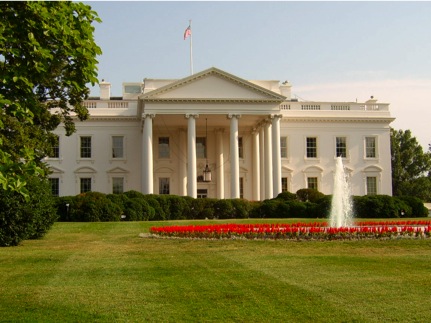

This year celebrates James Hoban
The White House, designed, built and rebuilt by Kilkenny-born James Hoban, is the enduring monument to the achievement and contribution of the Irish in the building of America.
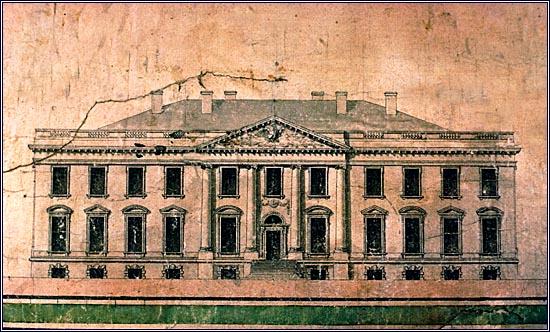
Drawing by James Hoban.
James Hoban was an Irish architect, best known for designing the White House in Washington, D.C..
Irish Roots | A County Kilkenny Man
Born in a thatched cottage on the estate of the Cuffe family, Earls of Desart at Cuffesgrange, near Callan in County Kilkenny, Ireland, James Hoban rose from journeyman carpenter and wheelwright to become the architect of the world's most famous house. Little is known of the Hoban family’s connection to the Cuffes, other than that Hoban's father Edward worked as a tenant farmer or an estate laborer on the Desart Court lands.
His mother Martha's maiden name was Bayne, and he had at least three siblings, Joseph, Philip, and Ann. Hoban, educated at the estate school, probably displayed a talent for drawing and design. With Lord Otway Cuffe's consent, and possibly his patronage, young Hoban attended the Dublin Society's Drawing School.
Hoban surely excelled in his studies, as he received the prestigious Duke of Leinster's medal for drawings of "Brackets, Stairs, and Roofs, & c." from the Dublin Society in 1780. He subsequently found a position as an apprentice to the Cork-born architect Thomas Ivory, the headmaster of the Dublin Society School from 1759 to 1786.
Major extant buildings in Dublin associated with Hoban's student years are the Glendower, Newcomen & Company bank building (today the Rates Office of the Dublin City Council) , designed by Ivory, and the Royal Exchange (1769-79), designed by English architect Thomas Cooley and recently restored as Dublin City Hall. Hoban must have been familiar with the Royal Exchange, for he gave President George Washington a detailed summary of its materials and cost in discussions related to the estimates for the President's House.
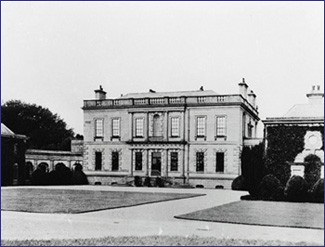
Desart Court, home of the Cuffe family, Barons Desart. Commissioned in 1733.
Hoban was raised on the estate of the Earl of Desart at Cuffesgrange, Co Kilkenny where he learned carpentry skills. He studied architecture at the Royal Dublin Society.
Following the American Revolutionary War, Hoban emigrated to the United States, and established himself as an architect in Philadelphia in 1781. Hoban went to South Carolina in 1792, where he designed numerous buildings including the South Carolina statehouse in Columbia.
In 1792, Hoban won the competition to design the presidential mansion, later known as the The White House.
Hoban was also one of the supervising architects who served on the Capitol, carrying out the design of Dr. William Thornton.
Hoban lived the rest of his life in Washington, D.C., where he worked on other public buildings and government projects, including roads and bridges. He also designed Rossenarra House near the village of Kilmoganny in Kilkenny, Ireland in 1824.
Hoban died in Washington, D.C. on December 8, 1831.
Ireland commemoration
A memorial arbor is being designed to honor James Hoban near his birth place and is expected to be completed this year 2008. A major exhibition on his life is to take place at the White House Visitor Center.
James Hoban: Architect of the White House
White House History Number 22
James Hoban built the White House in the 1790s for President George Washington. Hoban rebuilt the White House after it was burned by the British in the invasion of the United States in the War of 1812. And the White House has stood since, the home of the presidents of the United States. Hoban's house of stone has borne more than 200 years of presidential life and work and today is the most recognizable residence in the world.
Hoban's story is that of an ambitious and competent young man who left his native soil to find his fortune in America. He was a hard worker, probably a tough manager who led a disparate building crew consisting of Irish, English, Scots, and African Americans, some of them enslaved, to build to completion the first building in the new federal city the Americans established as their capital. He knew building from the ground up, having manned the trowel, mortar, hammer and saw himself in his days of training in Dublin. Schooled in design at a sort of trade or vocational school by the best architect, Thomas Ivory, Ireland had to offer at the time, he made fine drawings, always keeping his rather astute political eye sharpened to pleasing his powerful employers, the early presidents.
White House History, the journal of the White House Historical Association, has dedicated the entire spring issue to James Hoban and his era. Articles by experts from both sides of the Atlantic explore the world he knew and the world he saw. Desmond Guinness, the distinguished Irish architectural historian, leads with a feature on Irish country houses of the familiar type that so powerfully influenced Hoban's design for the White House. The heart and sounds of eighteenth century Dublin are resurrected by Holger Hoock of the University of Liverpool, England. William Bushong, historian of the White House Historical Association, draws Hoban from the iconography of the American past in portraits, advertisements, and newspaper stories.
James Hoban's life is a memorable Irish-American success story. In his boyhood he learned the craft of carpenter and wheelwright, and became an architect by profession and a builder by trade. Hoban came to America with high ambitions, and designed and erected many buildings, but what keeps his name alive today arises from one special commission – he was the architect of the White House.
Much about Hoban's life and personality remains a mystery. In his own time he was not the legendary figure he has since become. His personal and business papers, mostly lost in a fire in the 1880s, survive only in scattered drawings, public and legal documents, and newspaper notices. These sources reveal what is known of the details of his life.
Slave Owner
African Americans, enslaved and free, provided most of the manual labor and much of the skilled labor that erected the White House, the United States Capitol, and other early government buildings. Stonemason Collen Williamson trained slaves on the spot at the government's quarry at Aquia, Virginia. Slaves quarried and cut the rough stone that was later dressed and laid by Scottish masons to erect the walls of the President's House. The slaves joined a work force that included local white laborers and artisans from Maryland and Virginia, as well as immigrants from Ireland, Scotland, and other European nations.
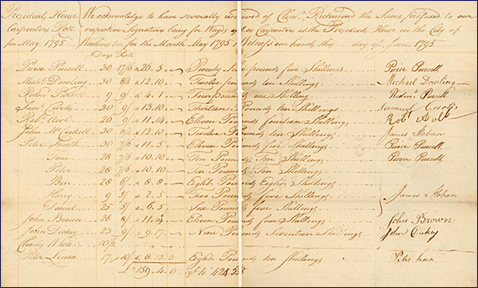
The payroll shows that the government did not own slaves, but that it did hire them from their masters. Slave carpenters Ben, Daniel, and Peter were noted as owned by James Hoban
Hoban’s contributions to the early growth and development of Washington, D.C., as architect, builder, mason, captain of a militia company, civic leader, and pillar of the Roman Catholic community, maintain his memory and reputation to this day.
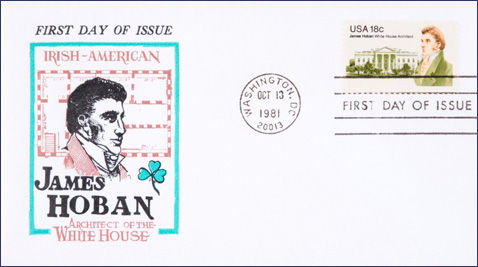
1981 stamp commemorating the 150th anniversary of Hoban's death.
|
|
|
|
|
|
|
|
|
|















